The team who wins the toss at the beginning of the game elects to either receive the ball or kick-off (they also select which side of the field they want to defend in each half). Then, the receiving team will kick-off to start the second half. Generally, teams winning the toss elect to receive in the first half so that they will have the opportunity to kick-off in the second. After a goal is scored, the team that was scored on will kick-off to resume play.
It is a good idea not to get too fancy on the kick-off. There is really no point in trying a super-creative move because there are so few kick-offs in a game. (While playing indoor soccer, it is more beneficial to pay attention to the kick-off because there are more of them and the field is smaller).
Basically, there are two things your players need to know about the kick-off: 1)the ball must cross the center line on the first touch and 2)the receiving team must stay beyond the center circle. It is possible to score directly off the kick-off (similar to a direct kick) but this is near-impossible. Sometimes it may be beneficial to boot it down to the opponent’s defensive corner and then run up on the ball, but this is generally done when the chips are down and time is running short. The kick-off can be set-up in one of two ways:
- The center forward lines up behind the ball, ready to pass to either of the two wings to each side or
- The center forward and one other player (center midfielder or one of the wings) stand inside the circle behind the ball, and one player prepares to tap it to the other player.
Most coaches opt for the second set-up, which allows more room for error. Since the opposing players must stay beyond the center circle, if the short pass goes awry, your team has more time to recover the ball than if the center forward’s longer pass to one of the wings goes awry.
Also, there are more possibilities when lining up with two players at the ball in the kick-off. All the ball needs to do is move forward over the center line, as long or as short as desired. In fact, one player can simply roll the ball forward under his or her foot and this counts as the kick-off. The second player can then “take” the ball from under the first player’s foot and dribble or pass to an open player or open space. Or, the first player can send a short pass to the second, who can then send it to the wings or send it back to the midfielders.
Again, it is generally advised to keep it simple on the kick-off. Indeed, this is a good opportunity for your players to practice sending to open space. As the ball is kicked-off, the wings and midfielders should be on the move, creating space, and the player with the ball can send a short or longer pass to the space in front of them. Here, your team is on the attack and all players are on the move, and there is a good opportunity to establish an offensive set-up.




